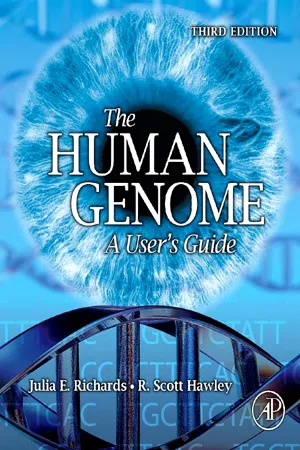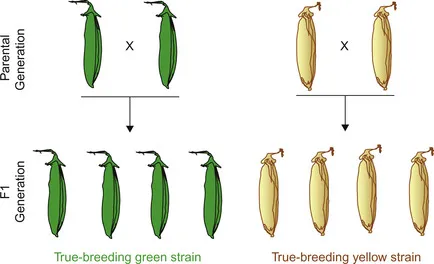
- 420 pages
- English
- ePUB (mobile friendly)
- Available on iOS & Android
eBook - ePub
The Human Genome
About this book
Significant advances in our knowledge of genetics were made during the twentieth century but in the most recent decades, genetic research has dramatically increased its impact throughout society. Genetic issues are now playing a large role in health and public policy, and new knowledge in this field will continue to have significant implications for individuals and society. Written for the non-majors human genetics course, Human Genetics, Third Edition will increase the genetics knowledge of students who are learning about human genetics for the first time. This thorough revision of the best-selling Human Genome, Second Edition includes entirely new chapters on forensics, stem cell biology, bioinformatics, and societal/ethical issues associated with the field. New special features boxes make connections between human genetics and human health and disease. Carefully crafted pedagogy includes chapter-opening case studies that set the stage for each chapter; concept statements interspersed throughout the chapter that keep first-time students focused on key concepts; and end-of-chapter questions and critical thinking activities. This new edition will contribute to creating a genetically literate student population that understands basic biological research, understands elements of the personal and health implications of genetics, and participates effectively in public policy issues involving genetic information.
- Includes topical material on forensics, disease studies, and the human genome project to engage non-specialist students
- Full, 4-color illustration program enhances and reinforces key concepts and themes
- Uniform organization of chapters includes interest boxes that focus on human health and disease, chapter-opening case studies, and concept statements to engage non-specialist readers
Frequently asked questions
Yes, you can cancel anytime from the Subscription tab in your account settings on the Perlego website. Your subscription will stay active until the end of your current billing period. Learn how to cancel your subscription.
No, books cannot be downloaded as external files, such as PDFs, for use outside of Perlego. However, you can download books within the Perlego app for offline reading on mobile or tablet. Learn more here.
Perlego offers two plans: Essential and Complete
- Essential is ideal for learners and professionals who enjoy exploring a wide range of subjects. Access the Essential Library with 800,000+ trusted titles and best-sellers across business, personal growth, and the humanities. Includes unlimited reading time and Standard Read Aloud voice.
- Complete: Perfect for advanced learners and researchers needing full, unrestricted access. Unlock 1.4M+ books across hundreds of subjects, including academic and specialized titles. The Complete Plan also includes advanced features like Premium Read Aloud and Research Assistant.
We are an online textbook subscription service, where you can get access to an entire online library for less than the price of a single book per month. With over 1 million books across 1000+ topics, we’ve got you covered! Learn more here.
Look out for the read-aloud symbol on your next book to see if you can listen to it. The read-aloud tool reads text aloud for you, highlighting the text as it is being read. You can pause it, speed it up and slow it down. Learn more here.
Yes! You can use the Perlego app on both iOS or Android devices to read anytime, anywhere — even offline. Perfect for commutes or when you’re on the go.
Please note we cannot support devices running on iOS 13 and Android 7 or earlier. Learn more about using the app.
Please note we cannot support devices running on iOS 13 and Android 7 or earlier. Learn more about using the app.
Yes, you can access The Human Genome by Julia E. Richards,R. Scott Hawley in PDF and/or ePUB format, as well as other popular books in Biological Sciences & Genetics & Genomics. We have over one million books available in our catalogue for you to explore.
Information
Chapter 1. The Basics of Heredity
How Traits Are Passed Along in Families
Outline
1.1 Mendel’s Laws4
What Mendel Did5
Concept: What Passes from One Generation to the Next Is Information7
Concept: Dominant Alleles Mask the Detection of Recessive Alleles8
Concept: One Allele Comes from Each Parent; One Allele Passes to Each Child9
1.2 Selection: Artificial, Natural, and Sexual12
Artificial Selection13
Natural Selection13
Sexual Selection14
1.3 Human Genetic Diversity15
1.4 Human Dominant Inheritance16
1.5 Human Recessive Inheritance19
Albinism Is Recessive20
Albinism and Carriers22
Transmission of Albinism in Families22
There Are Many Recessive Traits23
Pseudo-dominant Inheritance of a Recessive Trait25
1.6 Complementation27
1.7 Epistasis and Pleiotropy31
1.8 Complex Syndromes32
1.9 One Man’s Disease Is Another Man’s Trait34
The Reader’s Companion: As you Read, you should Consider
• Different historical models that explain how heredity works.
• The importance of other organisms as models for the study of human inheritance.
• What gets passed from one generation to the next that results in inheritance.
• The concept of allelic differences.
• The relationship between genotype and phenotype.
• The implications of having two copies of a gene but passing along only one.
• The concept of dominance and the ability of one allele to mask another.
• The concept of recessive inheritance of a trait from parents who lack that trait.
• The effects on inheritance if a trait can be caused by more than one gene.
• Epistasis and alleles that over-ride detection of what another gene is doing.
• Pleiotropy and the ability of a gene to have multiple effects.
• The difference between syndromes and traits affecting a single tissue type.
• The sociopolitical implications of putting labels on phenotypes.
1.1. Mendel’s Laws
In the beginning …
—Genesis 1:1
We suspect that people have been curious about how heredity works ever since they figured out where babies came from. It is important to note that our current sophistication in these matters is of fairly recent origin. There is an old saying that “like begets like,” but this seemingly obvious knowledge that children will be like their parents might have been surprising to some ancient Greeks who wrote about the progeny that resulted from mating members of different species, such as swans and sheep.
Farmers have long known that animal offspring often appeared to be a mixture of both of their parents. Thousands of years ago it was proposed that children resulted from a blending process, the mixing of maternal blood and paternal semen derived from blood, with all aspects of the organism being represented in the semen and the menstrual blood. Many others saw blending as involving some essential essence or particles coming from every part of each parent, but each offered a slightly different mechanism.
For long periods in our history, many people imagined that children were the offspring of only one parent (either the mother or the father). Some thought that babies were preformed in the father and sailed in sperm down the vaginal canal into awaiting uterine incubators. Drawings dating back to the seventeenth century show the tiny preformed individuals (now known as homunculi) that the early microscopists imagined they saw inside sperm. There were other schools of thought in which children were preformed only in their mothers; the father was thought to provide only a “vital spark” (much like jump-starting a dead battery). By the mid-nineteenth century, most people were willing to accept the concept that the traits observed in children were some mix of those observed in both parents and in both sets of grandparents.
In many cases, this was thought of in terms of a blending model of inheritance. Although there are many situations in which blending is not the best model of what is happening, blending was a concept that was easy to understand. If you mix red paint and white paint, you get pink paint, so why would such a mechanism not explain intermediate skin tones in someone who has one dark-skinned parent and one light-skinned parent? People imagined that there was some kind of substance, such as blood, that blended in the offspring to produce a mixture of traits in the child. (Note the term “blood relative,” which implies a shared ancestry, not relationship by marriage.)
Still, there were some surprises that blending did not explain: blue-eyed kids born to brown-eyed parents, blond children of raven-haired moms and dads, kids who are taller than either parent, and so on. Blending, although it made some sense for some traits such as height and weight, did not explain many traits.
It was into this rather curious intellectual environment that Gregor Mendel was born in 1822 (Box 1.1). Like Galileo, Newton, Darwin, and Einstein, Mendel’s vision would change the course of human understanding. That vision results from one simple set of experiments. As we tell you about Mendel, we will describe one of those magical moments in human cognition when a new set of concepts became beautifully obvious and clear.
Box 1.1
Mendel’s Original Works
Mendel’s Original Works
Because Mendel lived so recently (1822–1884), much is known about his life, his education, the world he lived in, and just how his discoveries were brought to light again many years after his death. Although we will describe enough about Mendel’s experiments to help you understand his conclusions, and the way they formed the basis of the science of heredity, we cannot begin to fully describe either Mendel himself or his work. If you want to know more about him, or if you want to read his original scientific writings (in English or in German), check out Mendelweb at www.mendelweb.org. This site does an excellent job of making both Mendel and his science more accessible by means of annotating his works and providing links to helpful items such as glossaries, reference materials, and related sites. Even if you don’t want to read Mendel’s writings in detail, it is worth checking out this excellent site.
What Mendel Did
Mendel was a monk with a garden plot who carried out a set of simple experiments that revolutionized our understanding of genetics. He worked with the pea plant (Figure 1.1). His experiments took years and involved more than 10,000 plants. He chose to study the inheritance (the passing of a characteristic from one generation to the next) of seven simple and obvious traits that could clearly be distinguished between different pea strains:
• Seed shape – round vs. wrinkled
• Seed color – yellow vs. green
• Flower color – white vs. colored
• Seedpod shape – inflated vs. constricted
• Color of the unripe seedpod – green vs. yellow
• Flower position – along the stem vs. at the ends
• Stem length – short vs. tall
 |
| Figure 1.1 Pea plants show variation in many different characteristics including height, flower color, pod color, and pattern in which the flowers are clustered on the stems. (Courtesy Edward H. Trager.) |
These were simple “yes-or-no” traits and not quantitative traits such as weight that can vary over a wide range of different values. Some traits, such as stem length, can vary under different conditions such as rich vs. poor soil, so Mendel focused on simple binary traits – traits that were “yes” (wrinkled) or “no” (smooth) – traits that did not change classification between “yes” and “no” if the environmental conditions changed. For instance, when comparing tall and short plants, the tall plants were not all the same height, but they were so much taller than the short plants that the two categories were never mistaken for each other.
But perhaps the MOST significant aspect of Mendel’s experiments was that, unlike any of his predecessors, he began with pure-breeding populations of plants. For example, he had a strain of plants with yellow seedpods that produced only plants with yellow seedpods when bred to each other. Similarly, he had a strain of plants with green seedpods that produced only plants with green seedpods when bred to each other (Figure 1.2).
 |
| Figure 1.2 True-breeding pea strains represented by the peapods that the plants produce. Unlike the plants in these drawings, pea plants in most gardens often show a lot of variation in characteristics such as colors of flowers, peas, peapods, and size or shape of peas, peapods, and stems. By protecting plants from random pollination by other plants and then carrying out artificial pollination, Mendel was able to control which plants were being crossed to each other. He identified some strains that bred true for a particular characteristic, with each succeeding generation of the true-breeding strain producing progeny that were exactly like all of the preceding generations for the particular characteristic being looked at. The color of the immature peapod is one example of a characteristic for which he found true-breeding strains. |
Mendel crossed two plants by using pollen from one plant to fertilize another plant, and then studying the characteristics of the progeny and comparing those characteristics to the characteristics of the parental plants. Please note that in the first generation, when Mendel crossed plants with green seedpods to plants with yellow seedpods, all he saw in the progeny were plants with seedpods identical in color to those of the green seedpod parent. None of the plants had seedpods of an intermediate color (Figure 1.3).
 |
| Figure 1.3 Making hybrid plants. If you cross plants that consistently produce green seedpods with plants that consistently produce yellow seedpods, the result will be a whole generation of hybrid green-seedpod plants in offspring (called the F1 generation). Breeding together plants from strains with different characteristics produces a hybrid plant. Hybrid green-pod plants from the F1 generation, when crossed to each other, produce both green-pod plants and yellow-pod plants in the F2 generation. On average, three-quarters of plants in F2 will make green pods and one-quarter will make yellow pods. |
This experiment helped rule out several of the old ideas about inheritance. A real adherent to blending would ha...
Table of contents
- Cover Image
- Table of Contents
- Front-matter
- Copyright
- Dedication
- Acknowledgments
- Prologue. The Answer in a Nutshell
- Chapter 1. The Basics of Heredity
- Chapter 2. The Double Helix
- Chapter 3. The Central Dogma of Molecular Biology
- Chapter 4. The Genetic Code
- Chapter 5. We Are All Mutants
- Chapter 6. Mitosis and Meiosis
- Chapter 7. The Odd Couple
- Chapter 8. Sex Determination
- Chapter 9. Complexity
- Chapter 10. The Multiple-Hit Hypothesis
- Chapter 11. The Gene Hunt
- Chapter 12. The Human Genome
- Chapter 13. Genetic Testing and Screening
- Chapter 14. Magic Bullets
- Chapter 15. Fears, Faith, and Fantasies
- Answers to Study Questions
- Glossary
- Index